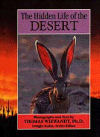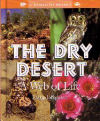Living in the Desert Additional Information
You can learn more about research on sand gazelles at www.eurekalert.org/pub_releases/2006-06/uocp-gsl060806.php (University of Chicago Press).
Information about kangaroo rats can be found at en.wikipedia.org/wiki/Kangaroo_rat(Wikipedia).
Additional information about animal life in South Africa’s Namib Desert is available at www.pbs.org/edens/namib/(PBS).
Sohn, Emily. 2004. Improving the camel. Science News for Kids (March 10). Available at http://www.sciencenewsforkids.org/2004/03/improving-the-camel-2/.
LabZone
Make a Solar Still
http://www.sciencenewsforkids.org/articles/20041006/LZActivity.asp
Books recommended by SearchIt!Science:
 |
Sand and Fog: Adventures in Southern Africa — Jim Brandenburg
Published by Walker & Co., 1994.
In the place described in this book, sand is everywhere. Dunes are up to 1,200 feet high. This stark and sandy wasteland in Namibia, Africa, has its own kind of beauty. Photographer Jim Brandenburg invites you on a journey to explore the ever-changing landscape. He finds his images in simple things—from a lizard that buries itself in the sand to avoid the midday sun to the fur seals that surf along the shoreline to the zebras that emerge from the dusty fog at a waterhole. Everywhere, the desert creatures have adapted themselves for survival in the harsh, dry conditions. Brandenburg’s photographs depict the people of Namibia and one of their important industries—diamond mining. Through each photograph, he celebrates the cycle of life and death in the South African desert. |
 |
The Hidden Life of the Desert— Thomas Wiewandt
Published by Random House, 1990.
The lizards of the Sonoran desert in the U.S. Southwest take a sunbath every morning to warm up before they begin hunting. Jackrabbits use their giant ears to radiate the desert’s fierce heat, keeping them cool. Other animals, such as the peccary, come out only on cooler days or at nighttime. This book takes you to the Sonoran desert and shows you how each animal copes with the harsh conditions. Close-up color photographs of desert creatures in action—a roadrunner eating a lizard, a peccary devouring a cactus, and a scorpion carrying its babies on its back—show the variety of life that exists during a five-season desert year. The author also discusses how people create desert conditions by stripping vegetation from fertile land. |
 |
The Dry Desert: A Web of Life— Philip Johansson
Published by Enslow Publishers, 2004.
This introduction to the desert biome begins by focusing on the work of Harold Avery, who is investigating how desert tortoises manage to use the desert’s sparse resources. Find out about many of the desert’s animals and plants in this book, which explains how the flora and fauna of the biome work together. The author explains the energy flow in the desert, the desert’s harsh climate, and how plants and animals have adapted to it. |
Power Words
kidney Either of two organs in humans and other vertebrates that separate waste materials from the blood in the form of urine. The kidneys control the amount of water in the body. Each kidney is attached to the bladder by a long tube called a ureter.
liver A large organ in the abdomen of humans and other vertebrates. The liver makes bile, which helps the body absorb food during digestion. The liver also stores sugars and vitamins, removes waste materials and poisons from the blood, and helps keep a steady amount of blood in the body.
mitochondria The tiny parts of a cell that change food into energy for use in growth and functioning of a living thing. Mitochondria are found in all cells except bacteria. Singular form: mitochondrion.
urine A clear or yellow fluid that is made in the kidneys and stored in the bladder before leaving the body as waste. The kidneys make urine by filtering waste products from the blood.
Copyright © 2002, 2003 Houghton-Mifflin Company. All rights reserved. Used with permission.
